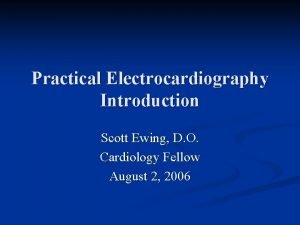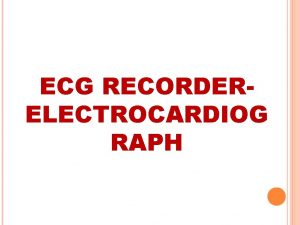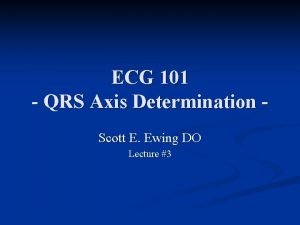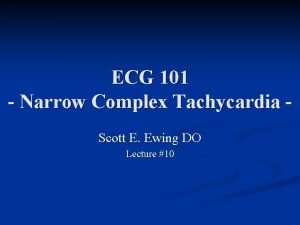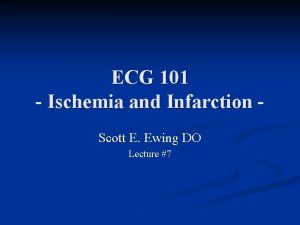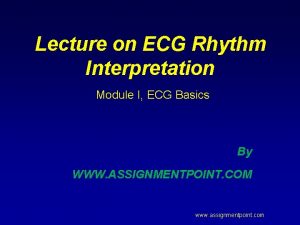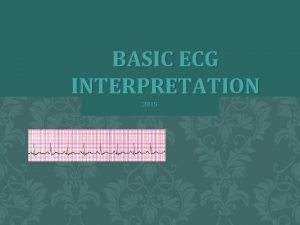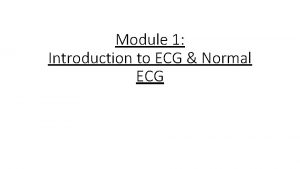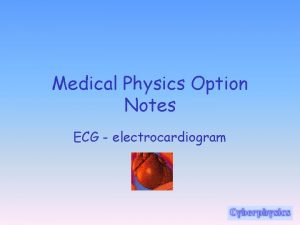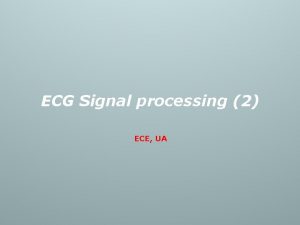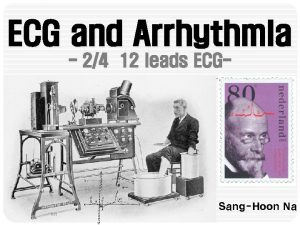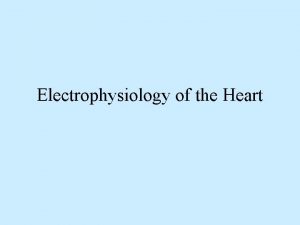ECG Lecture Scott Ewing D O March 23


















- Slides: 18

ECG Lecture Scott Ewing, D. O. March 23, 2006

Question #1 n The patient is an elderly man who presented to the emergency ward with dizziness and new renal failure


Hyperkalemia n n Hyperkalemia (7. 6 m. Eq/L) secondary to renal failure Findings consistent with severe hyperkalemia n n Widening of the QRS complex Peaking of the T waves Prolongation of the PR interval and flattening of the P waves If left untreated, the ECG will progress to a sinusoidal pattern and eventually asystole with subsequent hemodynamic collapse and death

Question #2 A 65 -year-old man n What should you do before calling cardiology fellow for a "hyperacute myocardial infarction" here? n


Hyperkalemia n n n Classic hyperkalemia with tall peaked T waves, along with PR prolongation and underlying left ventricular hypertrophy (LVH) (patient has renal disease with hypertension) Note QRS prolongation also seen with moderate-severe hyperkalemia Potassium here was 9. 6 m. Eq/L Not all tall positive T waves are "hyperacute“ The latter term should be reserved for increased T wave positivity secondary to transmural ischemia Major clues include narrowness (tenting) of T waves along with other findings noted above

Question #3 n This ECG is most consistent with which diagnosis? A. B. C. D. E. Acute anterior myocardial infarction Accelerated idioventricular rhythm Marked hyperkalemia Marked hypercalcemia Systemic hypothermia


Hyperkalemia The K+ was 10. 5 m. Eq/L in a patient with renal failure n Note the wide QRS complexes with no evident P waves n CK was normal and ST elevations were likely due to hyperkalemia. (Note: The apparent spike after the second QRS complex is an artifact. ) n

Question #4 A 38 -yr-old woman n What does the ECG show and what is the differential diagnosis? n


Hypokalemia n n n Sinus bradycardia with diffuse T wave flattening or inversions and markedly prominent U waves Best seen in leads V 2 and V 3 Most common causes n n Hypokalemia (K+ here was 2. 4 m. Eq/L) Drugs such as quinidine, phenothiazines, tricyclics Patients with hereditary long QT syndromes may show a similar finding This pattern is of great importance because it identifies patients at high risk of torsade de pointes type of polymorphic ventricular tachycardia

Question #5 30 -yr-old man with diarrhea, not on medication n What waveform is prominent? n What is the diagnosis? n


Hypokalemia n n There are very (!) prominent U waves with Q-T(U) prolongation He had severe hypokalemia (1. 5 m. Eq/L) due to diarrhea Calcium was normal, as was magnesium (remember pure hypocalemia prolongs ST segment primarily but doesn't give large U waves. ) Obviously, this acquired-type long-QT(U) syndrome puts subject at risk for torsade de pointes which he fortunately did not have before coming to hospital

Hyperkalemia n n ECG changes have a sequential progression of effects, which roughly correlate with the potassium level ECG findings may be observed as follows: n n n Early changes include peaked T waves, shortened QT interval, and ST segment depression Followed by bundle branch blocks causing a widening of the QRS complex, increases in the PR interval, and decreased amplitude of the P wave These changes reverse with appropriate treatment Without treatment, the P wave eventually disappears and the QRS morphology widens to resemble a sine wave. Ventricular fibrillation or asystole follows. ECG findings generally correlate with the potassium level, but potentially life-threatening arrhythmias can occur without warning at almost any level of hyperkalemia.

Hypokalemia n ECG findings may be observed as follows Flattening of the T wave, which is the earliest change n A "U wave" then develops, associated with ST-T wave flattening and sometimes slight ST depression n ST depression is more noticeable and the U wave increases in amplitude until ultimately the U wave overtakes the T wave. n At this point distinguishing between the T wave and U wave may be almost impossible ("Q-U" prolongation). n
 Scott ewing md
Scott ewing md Anthem of poland
Anthem of poland Ali ewing
Ali ewing Leah ewing ross
Leah ewing ross Ewing foundation
Ewing foundation Jason ewing
Jason ewing Gottron papula
Gottron papula Lciess
Lciess Ewing public schools
Ewing public schools 01:640:244 lecture notes - lecture 15: plat, idah, farad
01:640:244 lecture notes - lecture 15: plat, idah, farad Offset printing march
Offset printing march Joyful mysteries of the rosary
Joyful mysteries of the rosary Patrick royston
Patrick royston March 2013
March 2013 March kindergarten newsletter
March kindergarten newsletter Cscape envisionrv
Cscape envisionrv March 1 1803
March 1 1803 Grihalakshmi magazine march 2019
Grihalakshmi magazine march 2019 Royal march banner
Royal march banner
